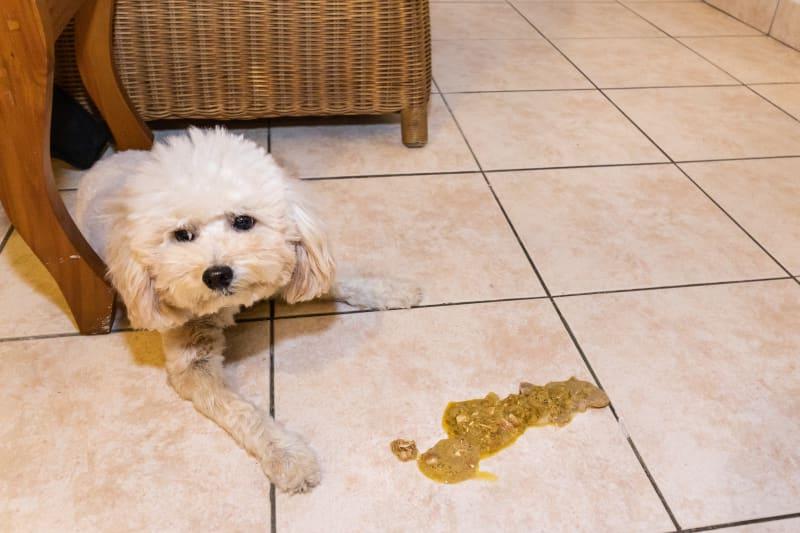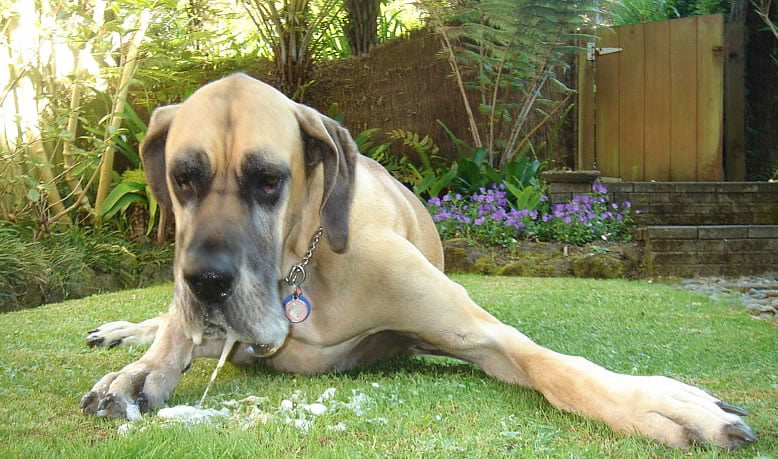Conclusion
Summary of key points on managing dog vomiting and stomach issues
Encouragement for proactive care and monitoring
Final advice for dog owners on maintaining their pet’s digestive health
Did you know that nearly 30% of dogs will experience some form of stomach issue in their lifetime? It’s a common concern for many pet owners. Stomach problems in dogs can range from mild to severe, with vomiting being one of the most frequent symptoms. This article aims to shed light on the causes, symptoms, and solutions for dog vomiting and other stomach issues. Understanding these can help you take better care of your furry friend and ensure they stay healthy and happy. From dietary indiscretions to more serious conditions, we’ll explore what might be causing your dog’s discomfort and how you can address it effectively.
Common Causes of Dog Vomiting

Dietary Indiscretion
Dogs are curious creatures, often exploring the world with their mouths. This can lead to dietary indiscretion, where they eat things they shouldn’t. From table scraps to random objects found on walks, these can upset their stomachs and lead to vomiting. Keeping an eye on what your dog consumes is crucial to prevent these incidents.
Food Allergies or Intolerances
Just like humans, dogs can have food allergies or intolerances. These can cause vomiting, along with other symptoms like itching or diarrhoea. Identifying the offending ingredient can be tricky, but switching to a hypoallergenic diet often helps.
Infections and Parasites
Infections and parasites are another common cause of vomiting in dogs. Bacterial or viral infections can upset their digestive system, while parasites like worms can wreak havoc. Regular vet check-ups and preventive treatments are key to keeping these issues at bay.
Chronic Conditions
Chronic conditions such as pancreatitis or kidney disease can also lead to vomiting. These are more serious and require ongoing management. If your dog frequently vomits, it’s important to consult a vet to rule out these conditions.
Symptoms to Watch For

Signs of Vomiting and Stomach Distress
Vomiting in dogs can be a one-off event or a sign of something more serious. Look out for repeated vomiting, especially if it’s accompanied by other symptoms like lethargy, diarrhoea, or a loss of appetite. Your dog might also show signs of stomach distress, such as excessive drooling, whining, or restlessness. These can indicate discomfort or pain in the stomach area.
When to Seek Veterinary Care
If your dog vomits once and seems fine afterwards, it might not be a cause for concern. However, if vomiting persists or is accompanied by other worrying symptoms, it’s time to see the vet. Blood in the vomit, a bloated abdomen, or signs of dehydration are red flags that need immediate attention.
Differences Between Acute and Chronic Symptoms
Acute symptoms appear suddenly and might resolve quickly, often due to something your dog ate. Chronic symptoms, on the other hand, develop over time and can indicate underlying health issues. If your dog has been vomiting regularly over weeks or months, it’s crucial to investigate further with your vet.
Diagnosis and Veterinary Assessment
Initial Examination and History Taking
When your dog is experiencing stomach issues, the first step is a thorough examination by a vet. They’ll ask about your dog’s recent behaviour, diet, and any other symptoms you’ve noticed. This history is crucial in narrowing down potential causes and guiding further investigation.
Diagnostic Tests
To get to the root of the problem, your vet might recommend some diagnostic tests. Blood tests can reveal infections or organ issues, while imaging like X-rays or ultrasounds can show blockages or abnormalities. In some cases, an endoscopy might be needed to look directly into the stomach and intestines. These tests provide a clearer picture of what’s going on inside your dog.
Importance of a Thorough Veterinary Assessment
A comprehensive veterinary assessment is essential for accurately diagnosing and treating your dog’s vomiting and stomach problems. It ensures that any underlying issues are identified and addressed promptly, preventing further complications. Trusting your vet’s expertise and following their recommendations can make all the difference in your dog’s recovery and long-term health.
Treatment Options

Dietary Changes and Feeding Recommendations
Adjusting your dog’s diet can be a game-changer when it comes to managing vomiting and stomach issues. Start by offering smaller, more frequent meals to ease digestion. Opt for easily digestible foods, like boiled chicken and rice, which are gentle on the stomach. If food allergies are suspected, a hypoallergenic diet might be necessary. Always introduce new foods gradually to avoid further upset.
Medications and Supplements
Sometimes, dietary changes aren’t enough, and medications or supplements are needed. Anti-nausea medications can help control vomiting, while probiotics support gut health. In cases of inflammation, your vet might prescribe anti-inflammatory drugs. Supplements like digestive enzymes can also aid in breaking down food more efficiently, reducing the risk of stomach issues.
Surgical Interventions for Severe Cases
In severe cases, where blockages or other serious conditions are present, surgery might be the only option. This is usually a last resort, but it can be lifesaving. Your vet will discuss the risks and benefits, ensuring you understand the procedure and recovery process. Post-surgery, careful monitoring and a tailored diet are crucial for a smooth recovery.
Home Care and Management
Tips for Managing Mild Cases at Home
When your dog is dealing with mild stomach issues, a little home care can go a long way. Start by withholding food for 12-24 hours to let their stomach settle. After this fasting period, introduce a bland diet like boiled chicken and rice in small portions. Keep an eye on their behaviour and any changes in symptoms.
Hydration and Electrolyte Balance
Hydration is crucial, especially if your dog has been vomiting. Ensure they have access to fresh water at all times. If they’re reluctant to drink, try offering ice cubes or a rehydration solution designed for pets. These can help maintain electrolyte balance and prevent dehydration.
Monitoring and Follow-Up Care
Keep a close watch on your dog’s condition. Note any changes in their appetite, energy levels, or stool. If symptoms persist or worsen, it’s time to consult your vet. Regular follow-up care ensures any underlying issues are addressed promptly, keeping your dog on the path to recovery.
Prevention Strategies
Preventing Dietary Indiscretion
Keeping your dog from eating things they shouldn’t is easier said than done, but it’s crucial. Start by dog-proofing your home. Keep food out of reach and ensure trash bins are secure. During walks, be vigilant about what your dog sniffs or picks up. Training commands like “leave it” can be a lifesaver in preventing them from eating harmful items.
Regular Health Check-Ups and Vaccinations
Regular vet visits are essential. They help catch potential issues early and keep your dog up-to-date on vaccinations. These check-ups are a great opportunity to discuss any concerns you might have about your dog’s diet or behaviour. Staying proactive with their health can prevent many stomach problems before they start.
Parasite Control and Hygiene Practices
Parasites can cause havoc in your dog’s digestive system. Regular deworming and flea treatments are a must. Keep their living area clean and wash their bedding frequently. Good hygiene practices, like washing your hands after handling your dog, also help prevent the spread of parasites. These simple steps can make a big difference in keeping your dog healthy.
When to Consult a Veterinarian
Red Flags That Require Immediate Attention
It’s crucial to know when your dog’s vomiting is more than just a minor issue. If you notice blood in the vomit, a bloated abdomen, or signs of dehydration, these are red flags that need immediate attention. Persistent vomiting, especially when paired with lethargy or a loss of appetite, also warrants a trip to the vet.
Importance of Timely Intervention
Timely intervention can make all the difference in your dog’s health. Addressing issues early can prevent them from escalating into more serious conditions. Quick action not only alleviates your dog’s discomfort but also reduces the risk of long-term complications.
Building a Relationship with Your Vet
Having a good relationship with your vet is invaluable. Regular check-ups and open communication ensure that your dog receives the best care possible. Your vet can provide tailored advice and support, helping you navigate any health concerns with confidence.
Final Thoughts
Dog vomiting and stomach issues are common but manageable concerns. By understanding the causes and symptoms, pet owners can take proactive steps to ensure their dog’s digestive health. From dietary adjustments to regular vet check-ups, these strategies empower owners to address and prevent stomach problems effectively. Remember, maintaining vigilance and fostering a strong relationship with your vet are key to your dog’s well-being. Stay attentive and proactive to keep your furry friend healthy and happy.
